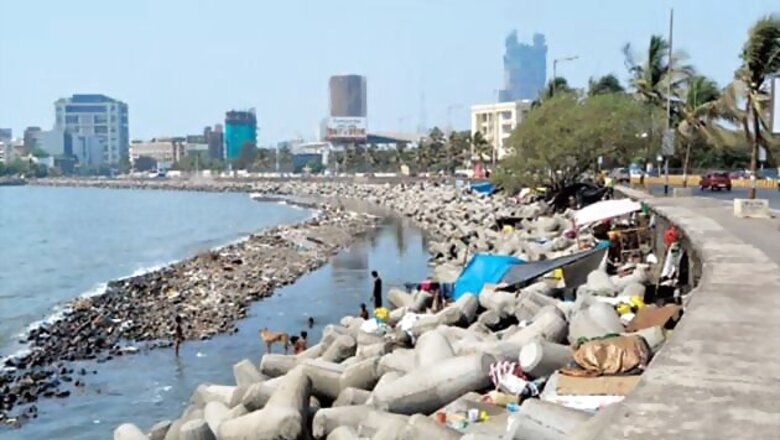
views
Mumbai: Cruising along the wavy road along the Haji Ali sea face to Worli, you would miss the frayed squares of cloth that balloon up on the other side of the embankment, where the tetra pods mark the start of reclaimed land. When you peer over, you see that the cloths form the roofs of tenuous makeshift houses built among the rocks, stretching between the Haji Ali jetty and Lala Lajpatrai College. A high tide can sweep them all away.
Yet, neither the police nor the civic administration is able to rein in these shanties — they spring right back after being razed down. Even on a VIP route like Haji Ali sea face, used routinely by politicians, ministers and foreign dignitaries. Its security and traffic management is supposedly a priority for the Mumbai Police. But when the president’s convoy passed by this coastal road a few days ago, the vagrants were there in their flimsy homes.
Not that it’s easy to drive them away. The cluster of shanties has earned the moniker ‘kuttawadi’, since its inhabitants let their dogs loose on municipal demolition squads that come to tear them down. In spite of all out efforts to remove these encroachments, they persist.
Maximum exposure
That it is an eyesore for those in the high-rises is beside the point, as is the debate on the marginalised versus the privileged. The overriding concern is law and order. If neglected, the shanties along Haji Ali coast — which allows access to the prime business district in the city — can degenerate into conduits for smugglers and traffickers.
More pressingly, they leave the coasts exposed. The city’s coastal security became a renewed priority for the police after the 26/11 attacks when Pakistani terrorists entered the city by slipping through the gaps in coastal security. The Indian Navy and Coast Guard increased their surveillance and reconnaissance in the Arabian Sea, and began additional patrolling along the coastline. Huge funds are poured in by the Centre to plug the holes in the coastal safety of the financial capital.
But the encroachments neuter these measures. They have been overlooked, despite the fact that they are in direct contact with the sea. Moreover, the shanties encroach upon the Coastal Regulatory Zone (CRZ), lying as they do on land’s end. When we contacted Minister of State for Home Satej Patil, he said, “The issue of encroachment in the city is very serious, and we will ask the BMC and local authorities to take strict action on priority.”
‘It’s our home’
People living in the settlements are mainly employed on small fishing boats, while others do odd jobs to eke out a living. Mohammed Ijam (63), a resident of one of the shanties, claimed that he had been living there for 25 years, and added, “This is the only place we will live. We do work like fishing and making chappals. Those who can’t have to resort to begging.” What if they are washed away in the lunar cycle? “The water rarely reaches up to this level, and even if it does, we climb up on the promenade above,” Ijam said.
A resident of the area, Shaikh Kadam, describes what seems to be a temporary solution to a permanent problem. “The settlements have been here as long as I can remember. The municipality comes twice a week and takes away their shelter and building materials, and the police comes to hassle them whenever a VIP visits the road. Despite these measures, the settlements are back within a few days, and the cycle continues. The people are reclusive and keep to themselves.”
Ask BMC: cops
The route is in the jurisdiction of the Tardeo police who are deployed to ensure law and order (bandobast duty). Constables are deployed near the Haji Ali jetty round the clock. When MiD DAY informed the cops on duty, they simply passed the buck to the BMC. “We can’t stop them from erecting shanties. The BMC conducts the demolition drives,” they said. When MiD DAY raised the coastal security aspect, they kept mum.
Mumbai Police spokesperson, Deputy Commissioner of Police Nisar Tamboli said, “The responsibility to remove these encroachments lies primarily with the BMC. However, we will never compromise with coastal security. We will review the spot and ask BMC to take necessary action on priority.”
Madhukar Pande, additional commissioner, Protection and Security, Mumbai Police said, “We do take action with the help of local authorities but the shanties regroup. We will discuss this issue with BMC authorities and devise ways and means to a permanent solution.”
‘We do what we can’
According to BMC officials from G-South ward, evictions are carried regularly but the vagrants return. “They are so violent at times that they attack us with their dogs, the reason why this locality is known as kuttawadi,” said a member of BMC staff who is in charge of eviction, on the condition of anonymity.
Narayan Pai, assistant municipal commissioner of G-North ward, said, “We take regular action against these settlements by confiscating their building materials like ropes and tarpaulin, to prevent any further construction. We do not want to allow any permanent residence.”
A senior official from the State Intelligence Department said, “The threat from the coasts was high two years ago, but now we have stepped up the vigil. Though cases of breach of security by foreign ships do exist, they are very rare.”

















Comments
0 comment